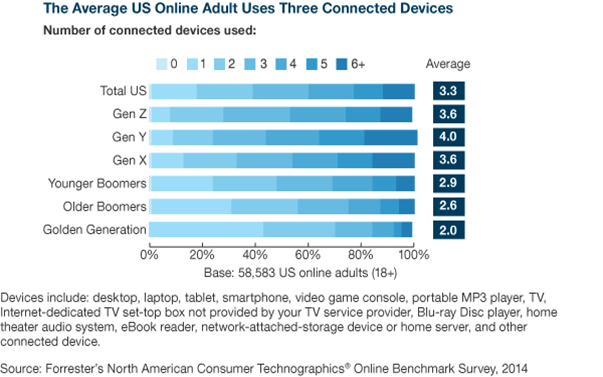Announcing Our Annual Benchmark On The State Of US Consumers And Technology In 2014
As the importance of technology to consumers continues to grow, pretty much anyone working for a company that wants to improve their customer experience needs to understand consumers’ technology behaviors. Questions companies ask include: “How did US consumers’ technology use change in 2014?” “Who are the early adopters of wearable devices?” “Are older adults using digital media?” “Are Millennials really ready to cut the cord?” These are just a few of the questions we answer in our newly released report on The State Of Consumers And Technology: Benchmark 2014, US. This data-rich report is a graphical analysis of a range of topics about consumers and technology and serves as a benchmark for consumers’ level of technology adoption, usage, and attitudes. Our annual benchmark report is based on Forrester's Consumer Technographics® online benchmark surveythat we've been fielding since 1998.
We analyze our findings through a generational lens, including Gen Z, Gen Y, Gen X, Younger Boomers, Older Boomers, and the Golden Generation. In 2014, we found that nearly all US consumers connected from multiple devices; even the Golden Generation (ages 70+) connected on an average of two. We also found that the majority of US online consumers personally use a smartphone, although just a minority show shifted behaviors (as defined by our Mobile Mind Shift Index). The graphic below shows the average number of connected devices that each generation uses: US online adults use three on average, while Gen Yers (ages 26 to 34) use the most.

The report goes into rich depth about consumer technology usage and behaviors, but here is a sneak peek at the answers to some of the questions above:
- Older Millennials are (still) the early-adopter generation. Gen Yers — the older Millennials — use the most connected devices; 85% use a smartphone and 53% use a tablet, the highest of any generation. They’re also the generation with the highest usage of emerging technologies; almost one in five uses a device to track their daily activity and get feedback on their eating habits.
- Even older generations have shifted their media consumption from traditional to digital channels. While Gen Zers (ages 18 to 25) and Gen Yers are more likely to read newspapers online than offline, older generations are also catching on. About half of Boomers (ages 49 to 69) and more than four in 10 online adults in the Golden Generation read newspapers online on a weekly basis.
- Younger generations are least likely to subscribe to cable — and most likely to cut the cord. Indeed, Gen Zers and Gen Yers are the age groups most likely to cut the cord. A third of Gen Zers do not have and never have had a cable subscription, while another 11% have canceled their subscription. More affordable online TV viewing options appeal to this audience — three-quarters watch TV online on a weekly basis.
These are some of the insights we capture. Our analysis is based on Forrester’s annual online benchmark survey that we run in our North American Consumer Technographics program. The full data set includes almost 2,000 data points and data on more than 150 US brands. We received more than 61,000 completed questionnaires in the US alone (we also cover Canada). It is our biggest consumer survey — in fact, it's the biggest and longest-running survey of consumers and technology in the world — and it covers the impact of technology on a variety of consumer markets, including automotive, consumer technology, banking, healthcare, marketing, media, retail, and travel. Please contact me if you'd like more information.